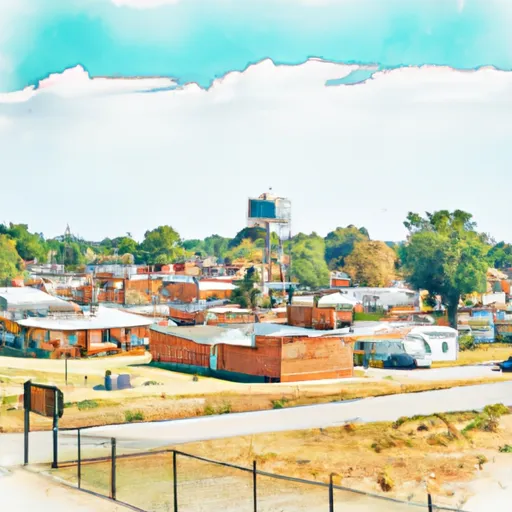-
 Snoflo Premium
Snoflo Premium
Get unlimited access to all our content
With no Ad interruptions! - Start Your Free Trial Login with existing account
Hoxie
Eden Index
Climate
8.0
•
Recreation
2.9
•
Community
2.2
•
Safeguard
4.8/10

Hoxie, Arkansas is a small town located in Lawrence County in the northeast region of the state. It has a humid subtropical climate characterized by hot and humid summers and mild winters. Summers in Hoxie are typically hot with temperatures often reaching the 90s Fahrenheit, while winters are generally mild with temperatures averaging in the 40s and 50s.
In terms of hydrology constituents, Hoxie is situated near the Black River, which provides a source of water for the community. Additionally, the town is surrounded by fertile farmlands and agricultural areas, contributing to the local hydrological system.
As for outdoor recreation opportunities, Hoxie offers various activities for nature lovers. The nearby Black River is ideal for activities like fishing, boating, and kayaking. The river is home to several species of fish, including bass and catfish, making it a popular spot for anglers. Hoxie is also surrounded by beautiful natural landscapes, providing opportunities for hiking, camping, and wildlife viewing.
Overall, Hoxie, Arkansas offers a pleasant climate, access to water resources, and a range of outdoor recreation opportunities for residents and visitors.
What is the Eden Index?
The Snoflo Eden Index serves as a comprehensive rating system for regions, evaluating their desirability through a holistic assessment of climate health, outdoor recreation opportunities, and natural disaster risk, acknowledging the profound impact of these factors on livability and well-being.
Climate Health Indicator (CHI): 8.0
Hoxie receives approximately
1243mm of rain per year,
with humidity levels near 84%
and air temperatures averaging around
16°C.
Hoxie has a plant hardyness factor of
7, meaning
plants and agriculture in this region tend to thrive during the non-winter months.
By considering the ideal temperature range, reliable water supplies, clean air, and stable seasonal rain or snowpacks, the Climate Health Indicator (CHI) underscores the significance of a healthy climate as the foundation for quality living.
A healthy climate is paramount for ensuring a high quality of life and livability in a region, fostering both physical well-being and environmental harmony. This can be characterized by ideal temperatures, reliable access to water supplies, clean air, and consistent seasonal rain or snowpacks.
Weather Forecast
Streamflow Conditions
Upper White
Area Rivers
Upper White
Snowpack Depths
Upper White
Reservoir Storage Capacity
Upper White
Groundwater Levels
Recreational Opportunity Index (ROI): 2.9
The Recreational Opportunity Index (ROI) recognizes the value of outdoor recreational options, such as parks, hiking trails, camping sites, and fishing spots, while acknowledging that climate plays a pivotal role in ensuring the comfort and consistency of these experiences.
Access to outdoor recreational opportunities, encompassing activities such as parks, hiking, camping, and fishing, is crucial for overall well-being, and the climate plays a pivotal role in enabling and enhancing these experiences, ensuring that individuals can engage in nature-based activities comfortably and consistently.
Camping Areas
| Campground | Campsites | Reservations | Toilets | Showers | Elevation |
|---|---|---|---|---|---|
| Lamar Dixon Expo RV Center | 300 | 11 ft | |||
| Farr Park | 108 | 26 ft | |||
| Little Sunflower River | None | 107 ft | |||
| Grand Gulf Military Park | 42 | 238 ft | |||
| Natchez State Park | None | 236 ft | |||
| Clear Spgs Rec Area | 45 | 317 ft | |||
| Lake Bruin State Park | None | 75 ft | |||
| Lake End Park | 167 | 4 ft | |||
| Rocky Springs - Natchez Trace Pkwy | 22 | 235 ft | |||
| Lake End City Park | 74 | 4 ft |
Nearby Ski Areas
Catastrophe Safeguard Index (CSI):
The Catastrophe Safeguard Index (CSI) recognizes that natural disaster risk, encompassing floods, fires, hurricanes, and tornadoes, can drastically affect safety and the overall appeal of an area.
The level of natural disaster risk in a region significantly affects safety and the overall livability, with climate change amplifying these risks by potentially increasing the frequency and intensity of events like floods, fires, hurricanes, and tornadoes, thereby posing substantial challenges to community resilience and well-being.
Community Resilience Indicator (CRI): 2.2
The Community Resilience Indicator (CRI) recognizes that education, healthcare, and socioeconomics are crucial to the well-being of a region. The CRI acknowledges the profound impact of these elements on residents' overall quality of life. By evaluating educational resources, healthcare accessibility, and economic inclusivity, the index captures the essential aspects that contribute to a thriving community, fostering resident satisfaction, equity, and social cohesion.

